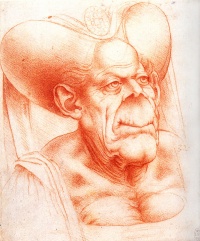Leonardo da Vinci
From The Art and Popular Culture Encyclopedia
|
"[The phallus ] confers with the human intelligence and sometimes has intelligence of itself, and although the will of the man desires to stimulate it, it remains obstinate and takes its own course, and moving sometimes of itself without license or thought by the man, whether he be sleeping or waking, it does what it desires; and often the man is asleep and it is awake, and many times the man is awake and it is asleep; many times the man wishes it to practice and it does not wish it; many times it wishes and the man forbids it. It seems therefore that this creature often has a life and intelligence separate from the man, and it would appear that the man is in the wrong in being ashamed to give it a name or exhibit it, seeking rather constantly to cover and conceal what he ought to adorn and display with ceremony as a ministrant." --da Vinci on the unruly member in his notebooks |

|
Related e |
|
Featured: |
Leonardo di ser Piero da Vinci (April 15, 1452 – May 2, 1519) was an Italian polymath: scientist, mathematician, engineer, inventor, anatomist, painter, sculptor, architect, musician, and writer.
He is best-known for his painting Mona Lisa and his drawing Vitruvian Man (c.1485).
His lesser-known works include several caricatures and grotesques.
Personal life
Within Leonardo's lifetime, his extraordinary powers of invention, his "outstanding physical beauty", "infinite grace", "great strength and generosity", "regal spirit and tremendous breadth of mind" as described by Vasari, as well as all other aspects of his life, attracted the curiosity of others. One such aspect is his respect for life evidenced by his vegetarianism and his habit, described by Vasari, of purchasing caged birds and releasing them.
Leonardo had many friends who are now renowned either in their fields or for their historical significance. They included the mathematician Luca Pacioli, with whom he collaborated on a book in the 1490s, as well as Franchinus Gaffurius and Isabella d'Este. Leonardo appears to have had no close relationships with women except for his friendship with Isabella d'Este. He drew a portrait of her while on a journey which took him through Mantua, and which appears to have been used to create a painted portrait now lost.
Beyond friendship, Leonardo kept his private life secret. His sexuality has been the subject of satire, analysis, and speculation. This trend began in the mid-16th century and was revived in the 19th and 20th centuries, most notably by Sigmund Freud.
Leonardo's most intimate relationships were perhaps with his pupils Salai and Melzi, Melzi describing Leonardo's feelings for him as both loving and intensely passionate. It has been claimed since the 16th century that these relationships were of a sexual or erotic nature. Court records of 1476, when he was aged twenty-four, show that Leonardo and three other young men were charged with sodomy, and acquitted. Since that date much has been written about his presumed homosexuality and its role in his art, particularly in the androgyny and eroticism manifested in John the Baptist and Bacchus and more explicitly in a number of erotic drawings.
See also
- Leonardo's notebooks
- Treatise on Painting
- Se la cosa amata e vile
- Leonardo da Vinci's anatomical drawings
- Rhombicuboctahedron by Leonardo da Vinci




